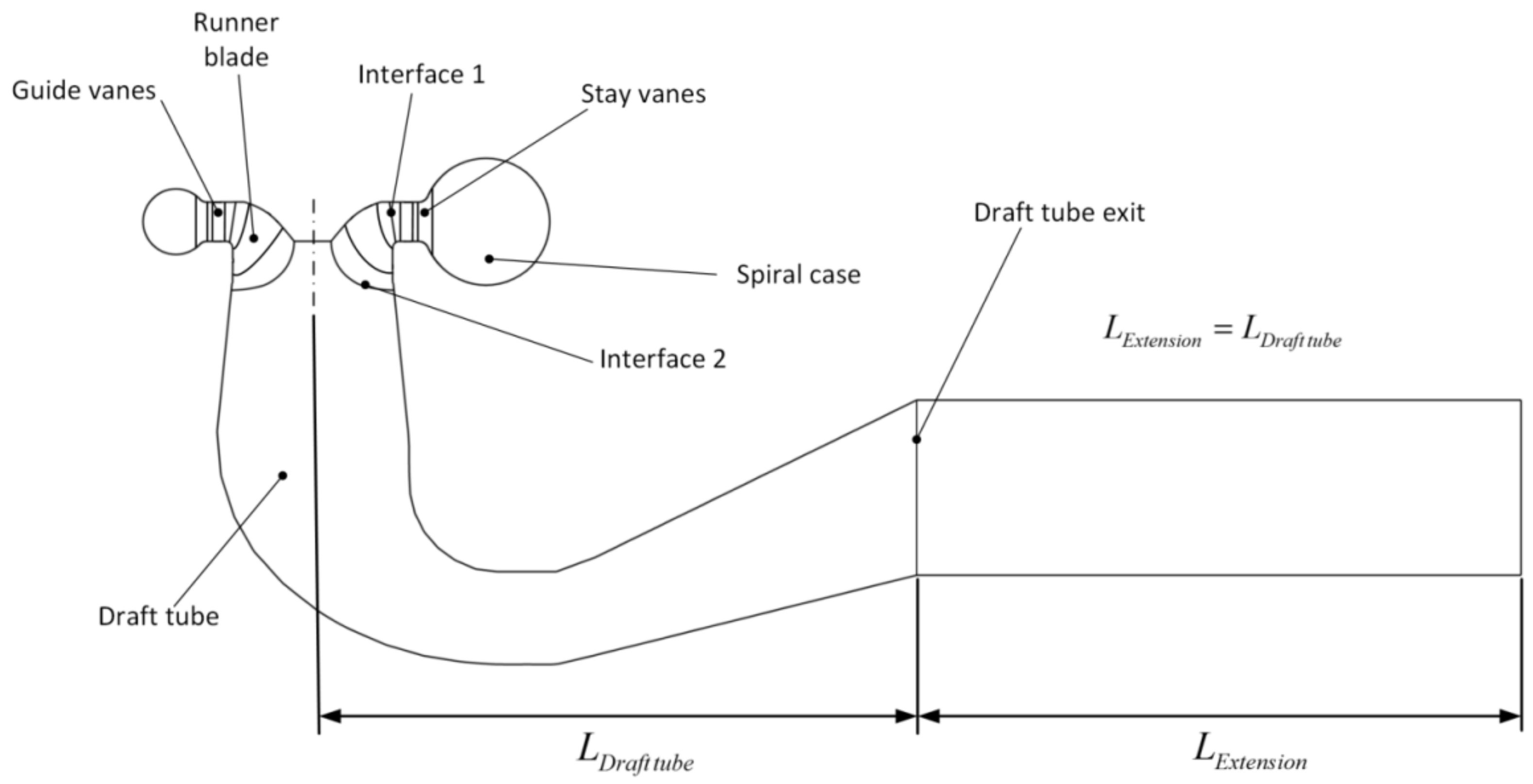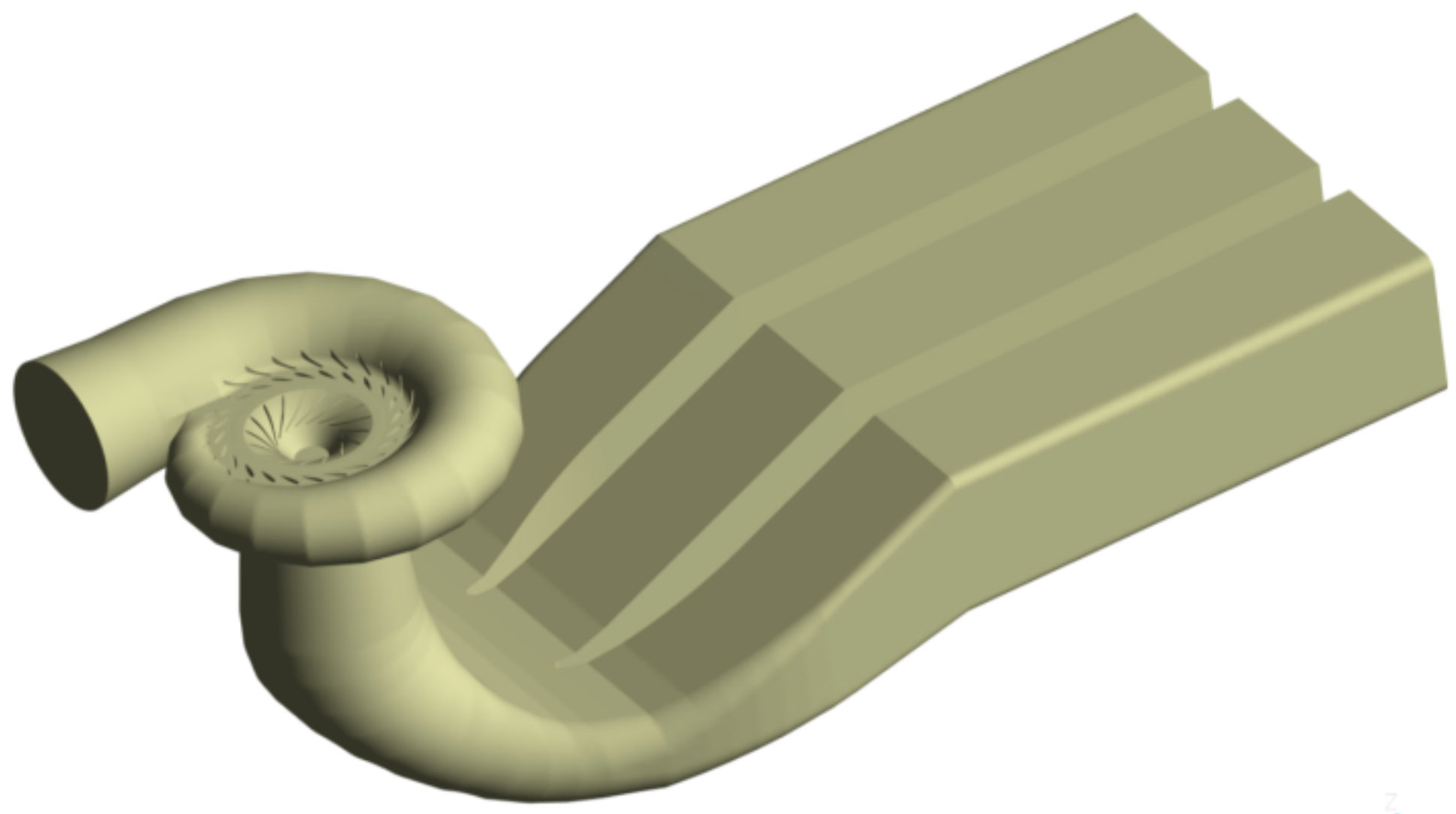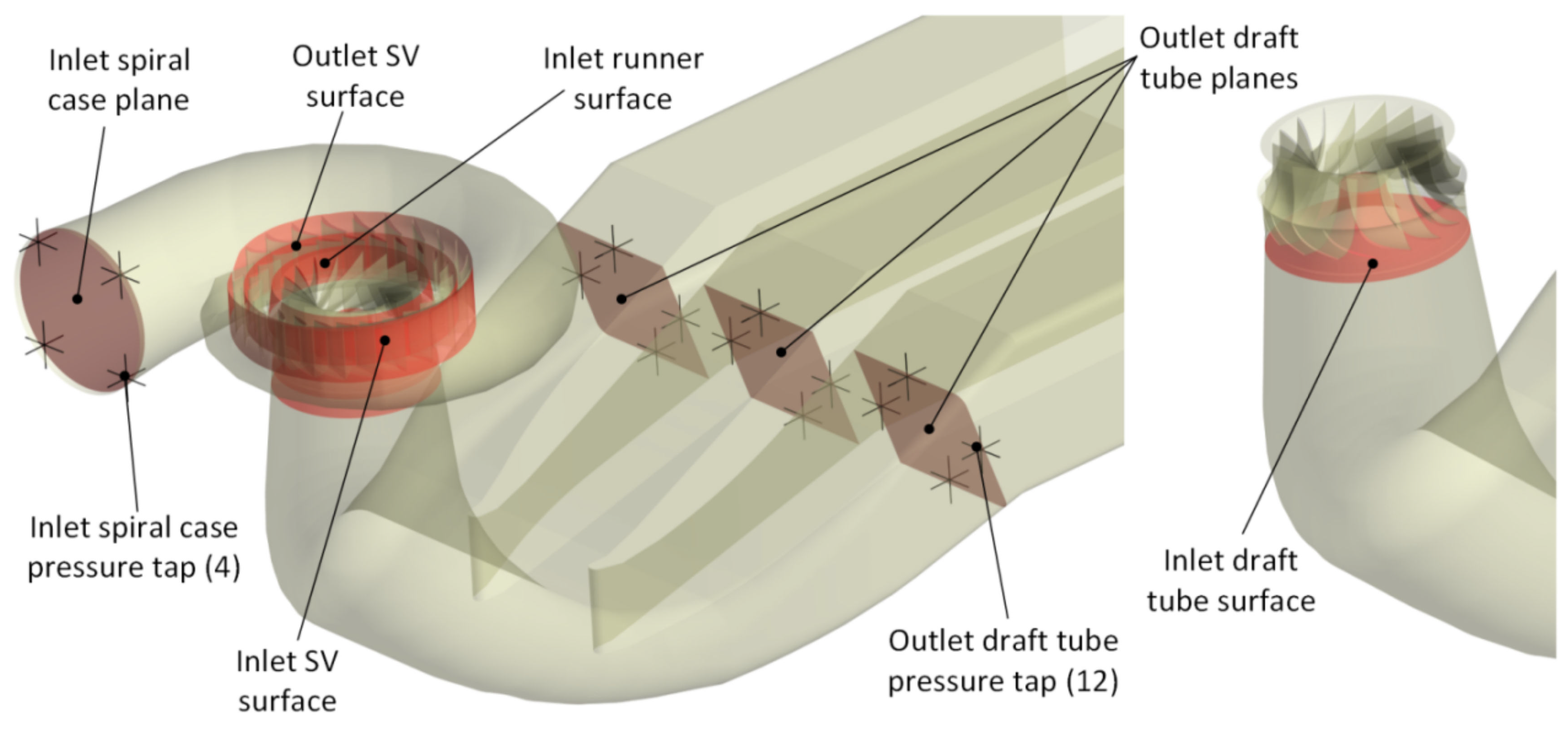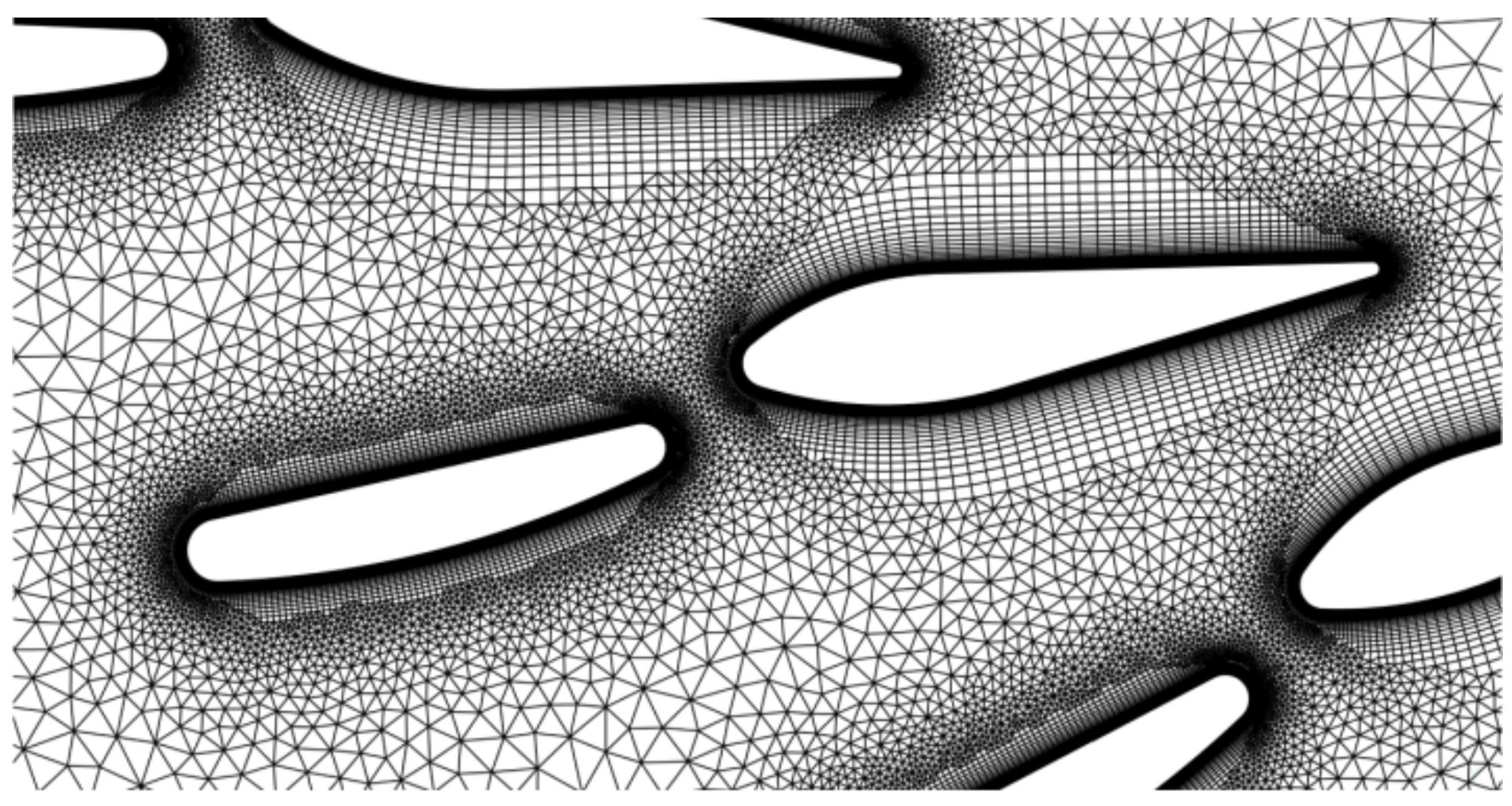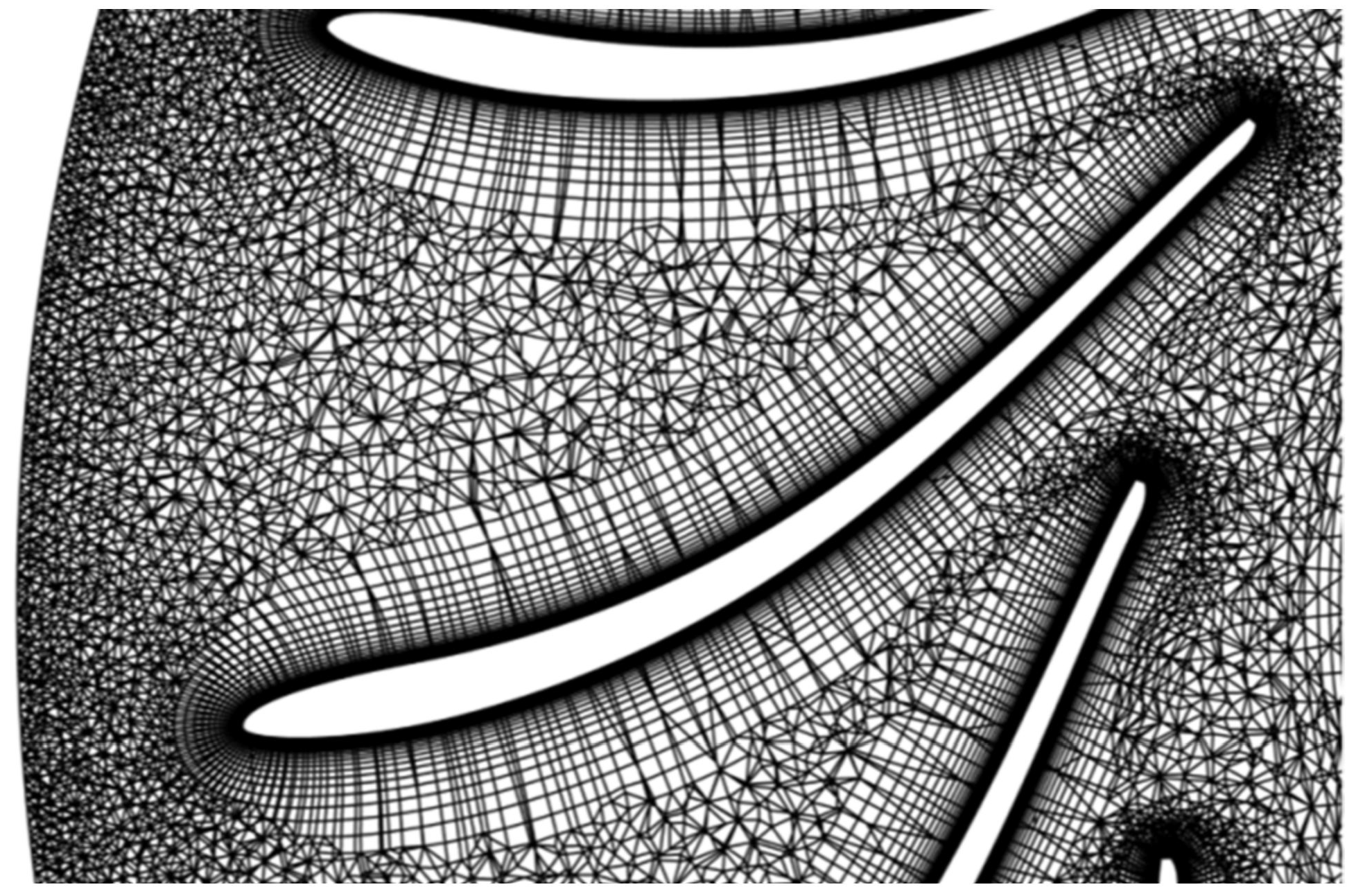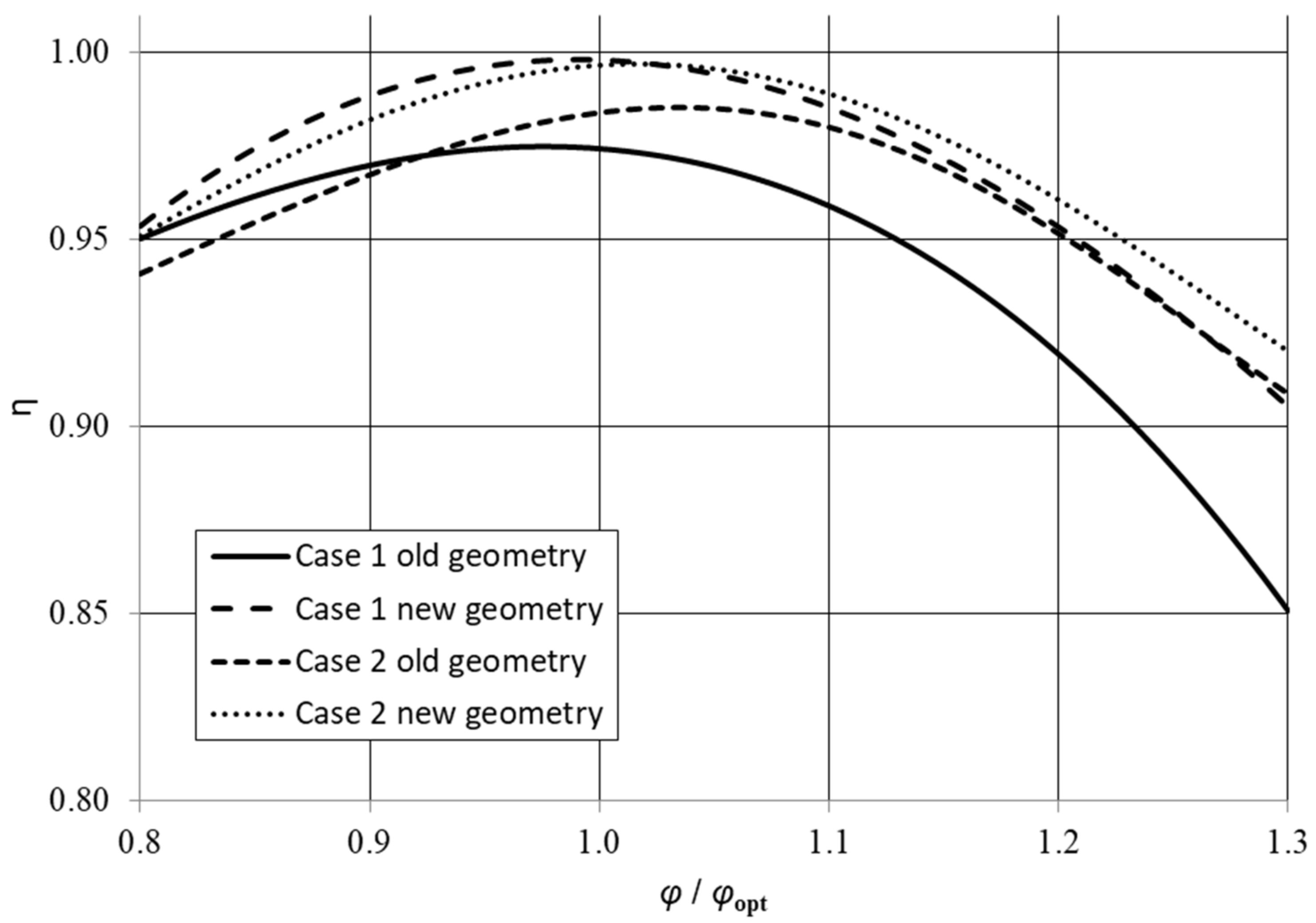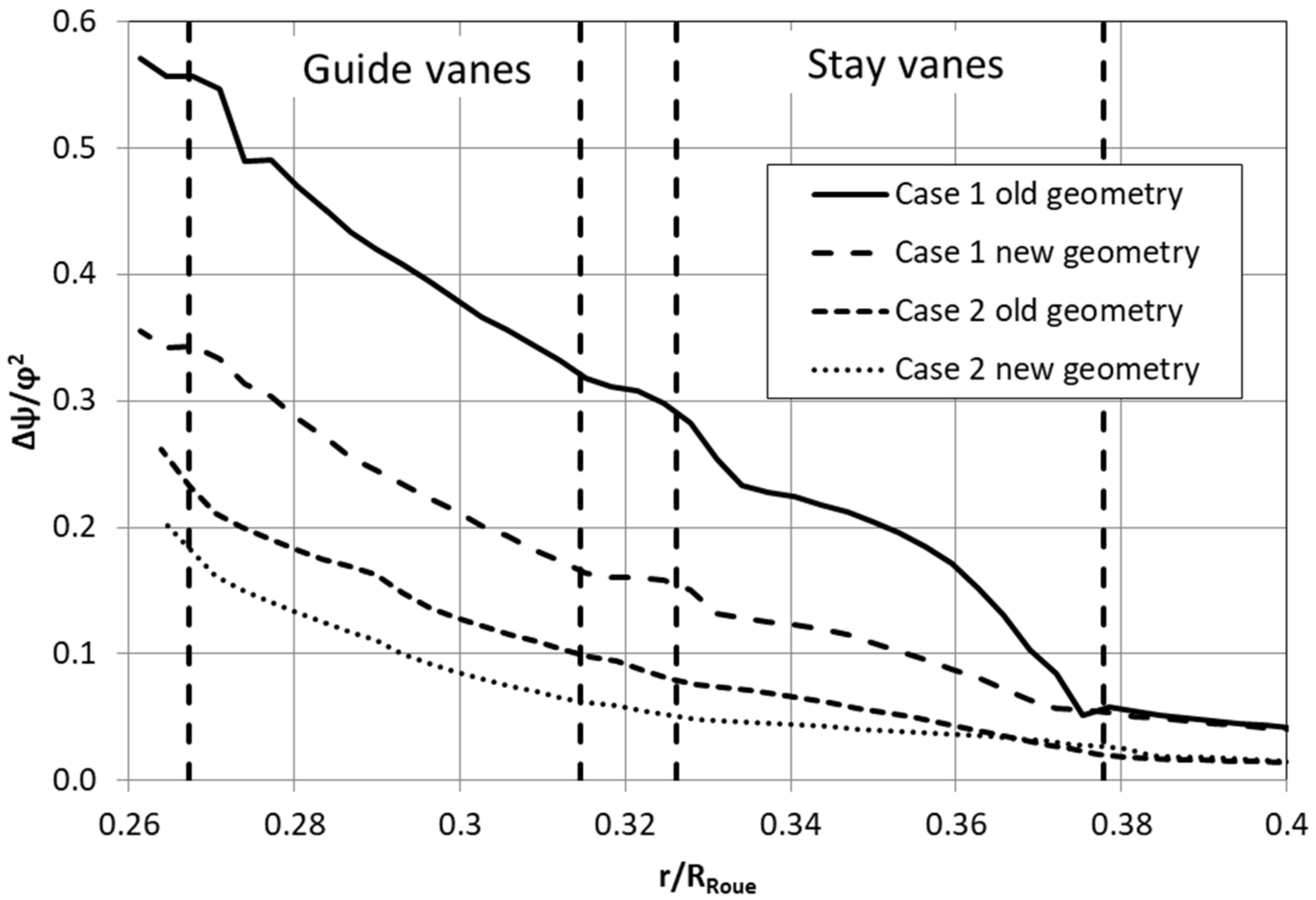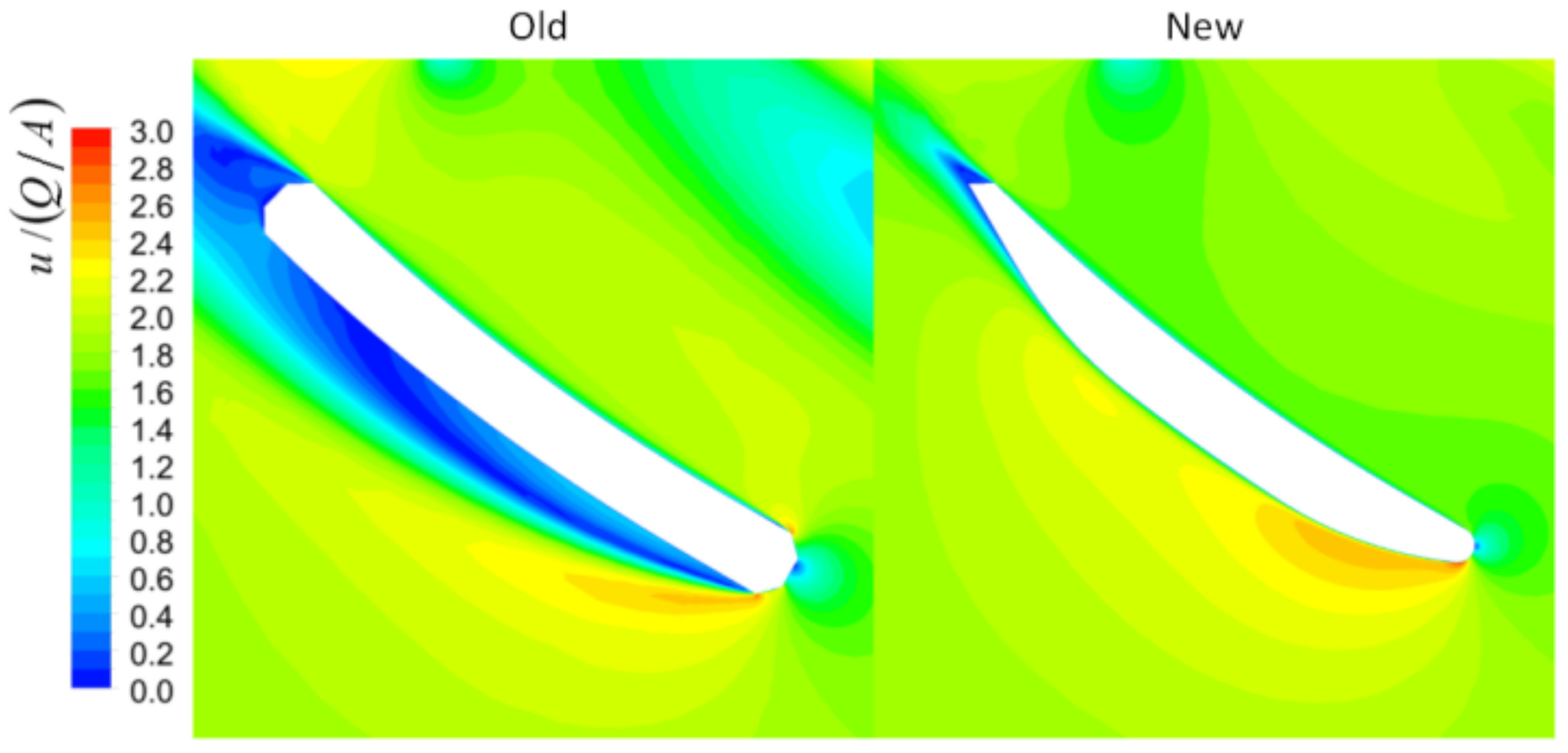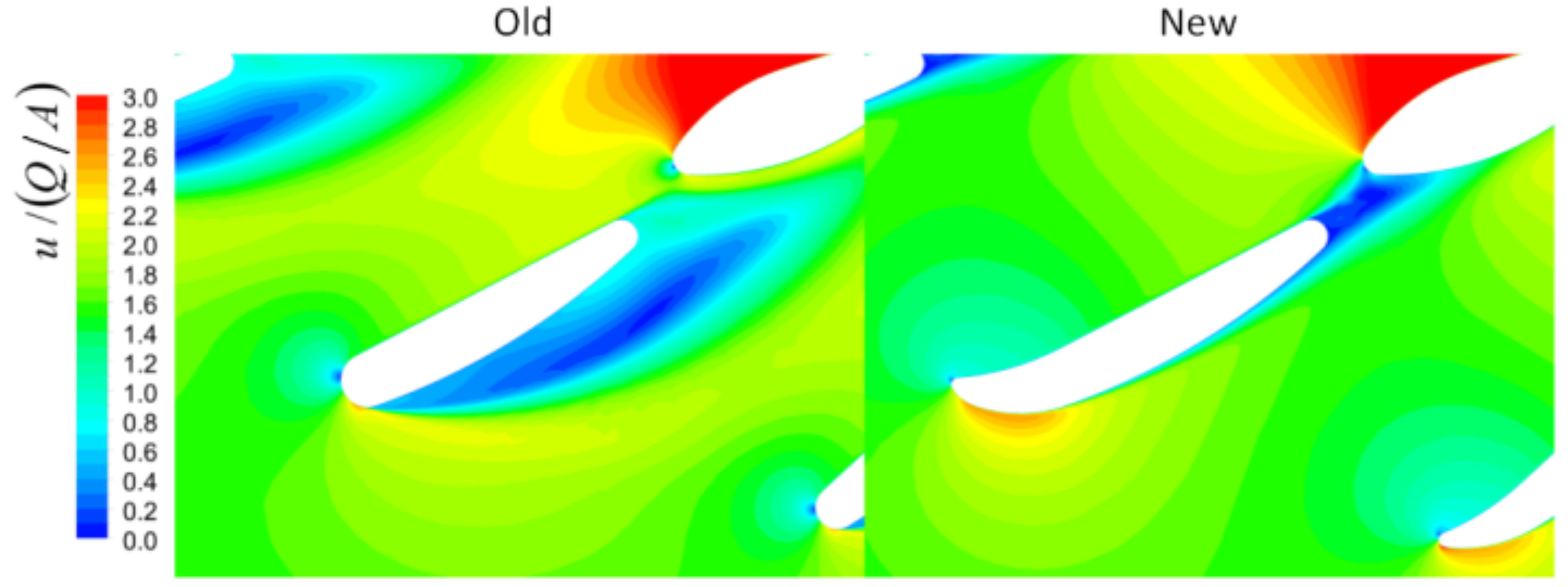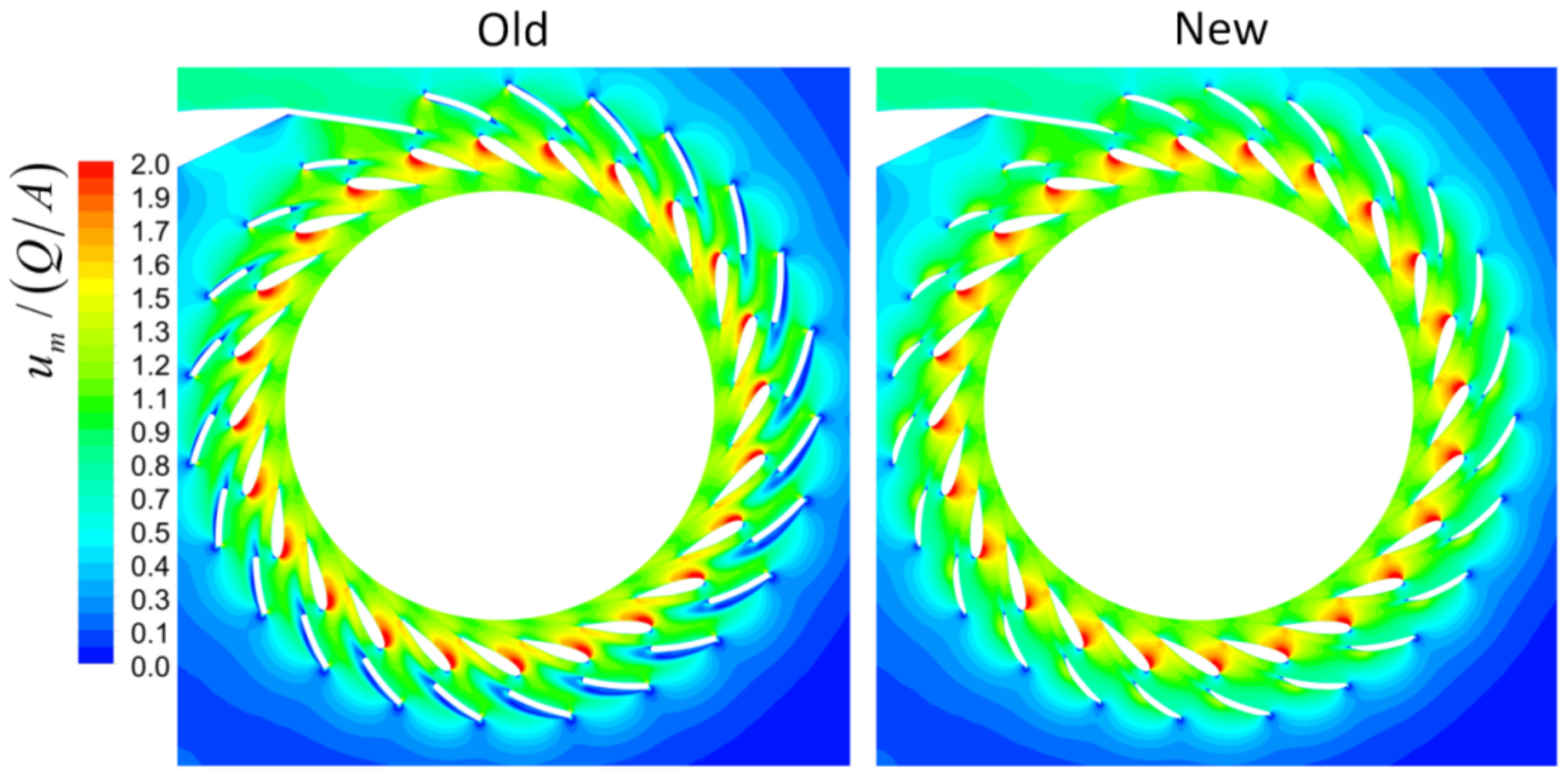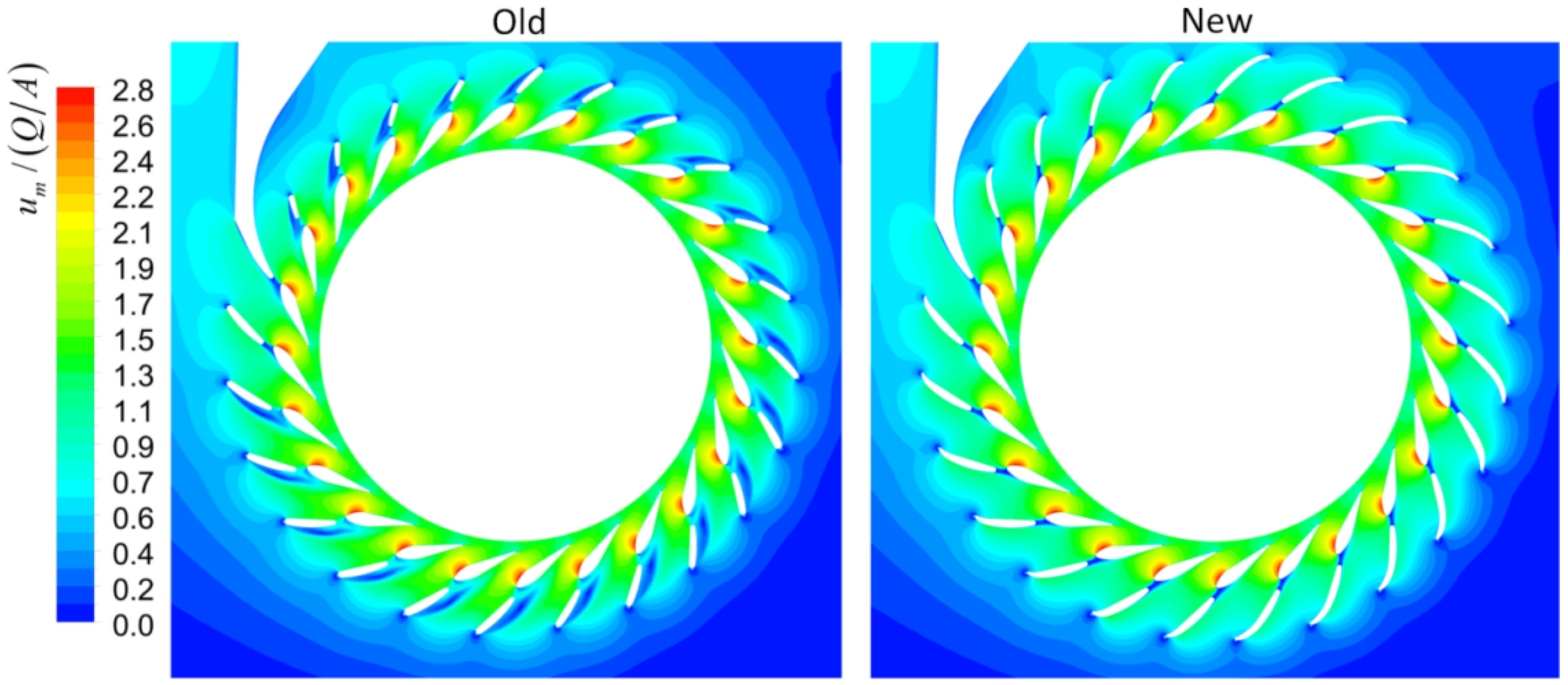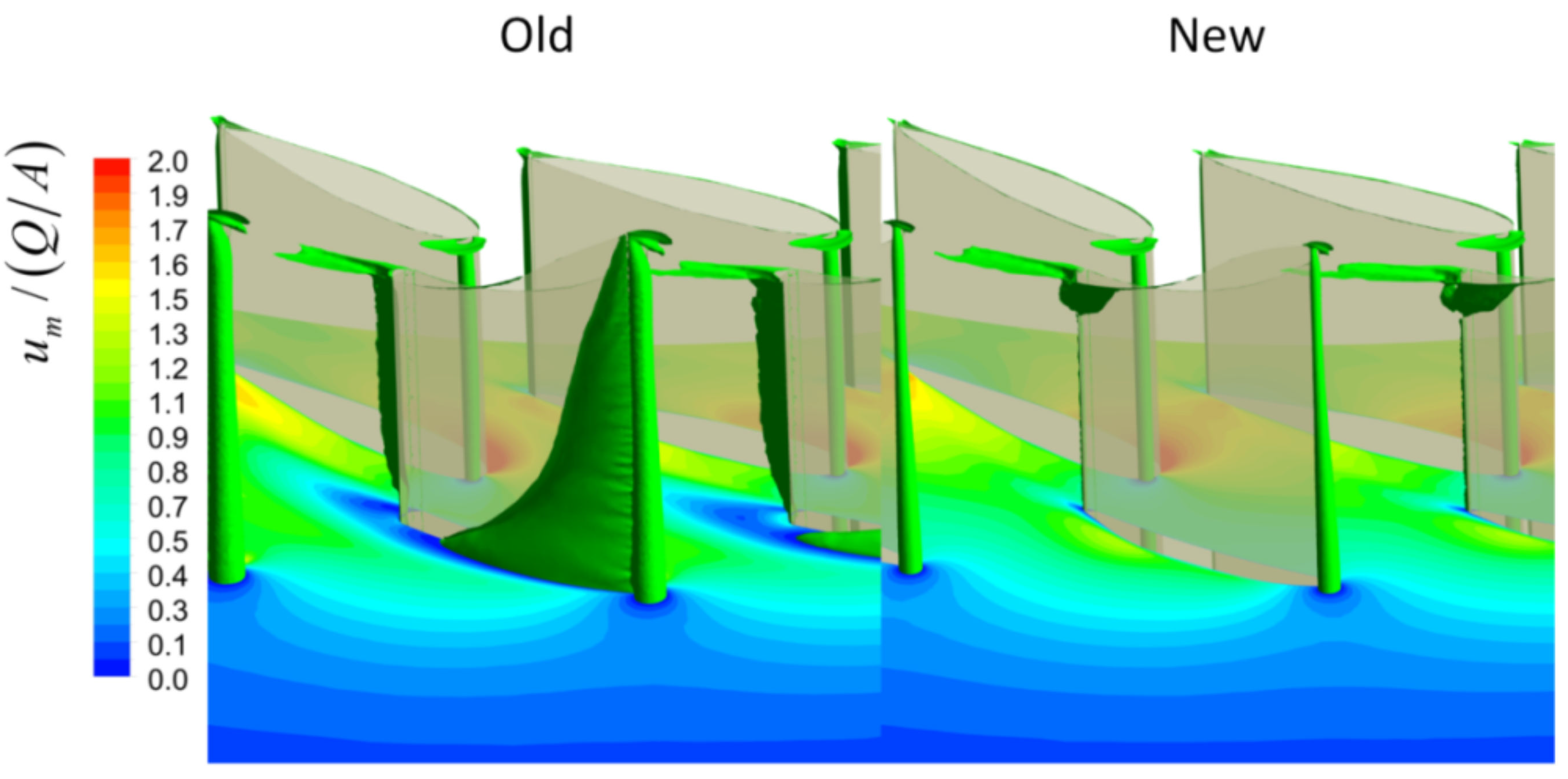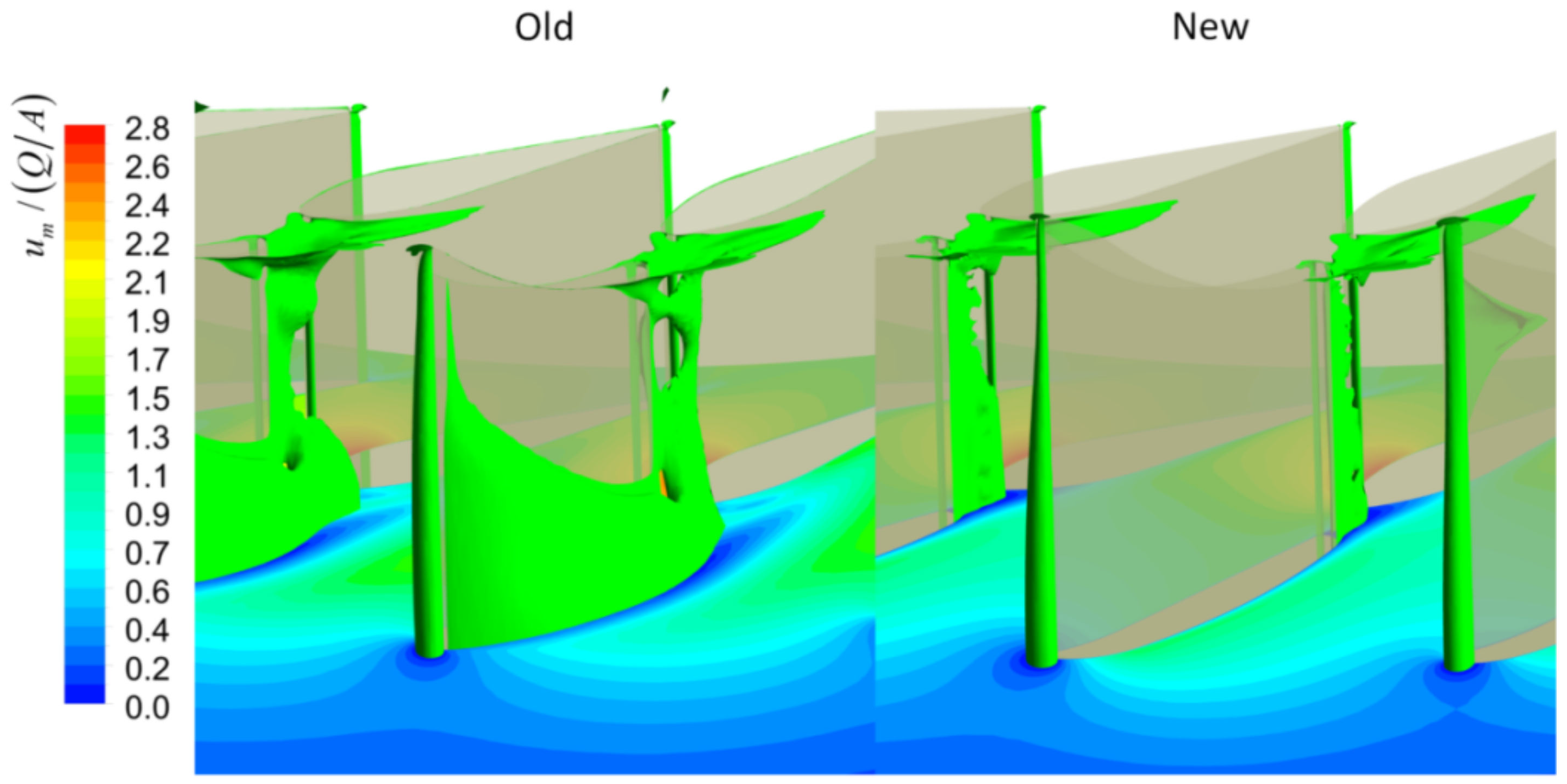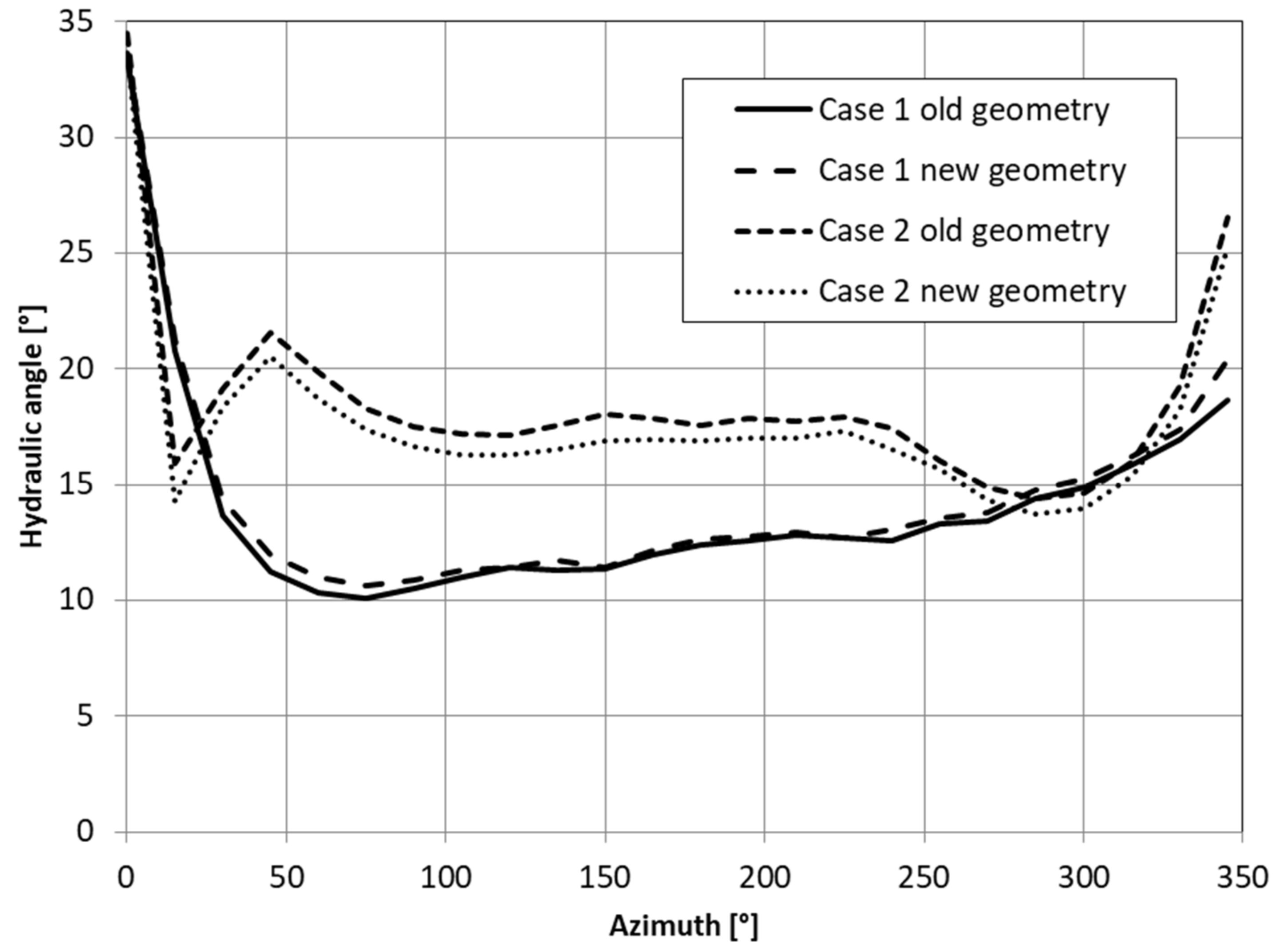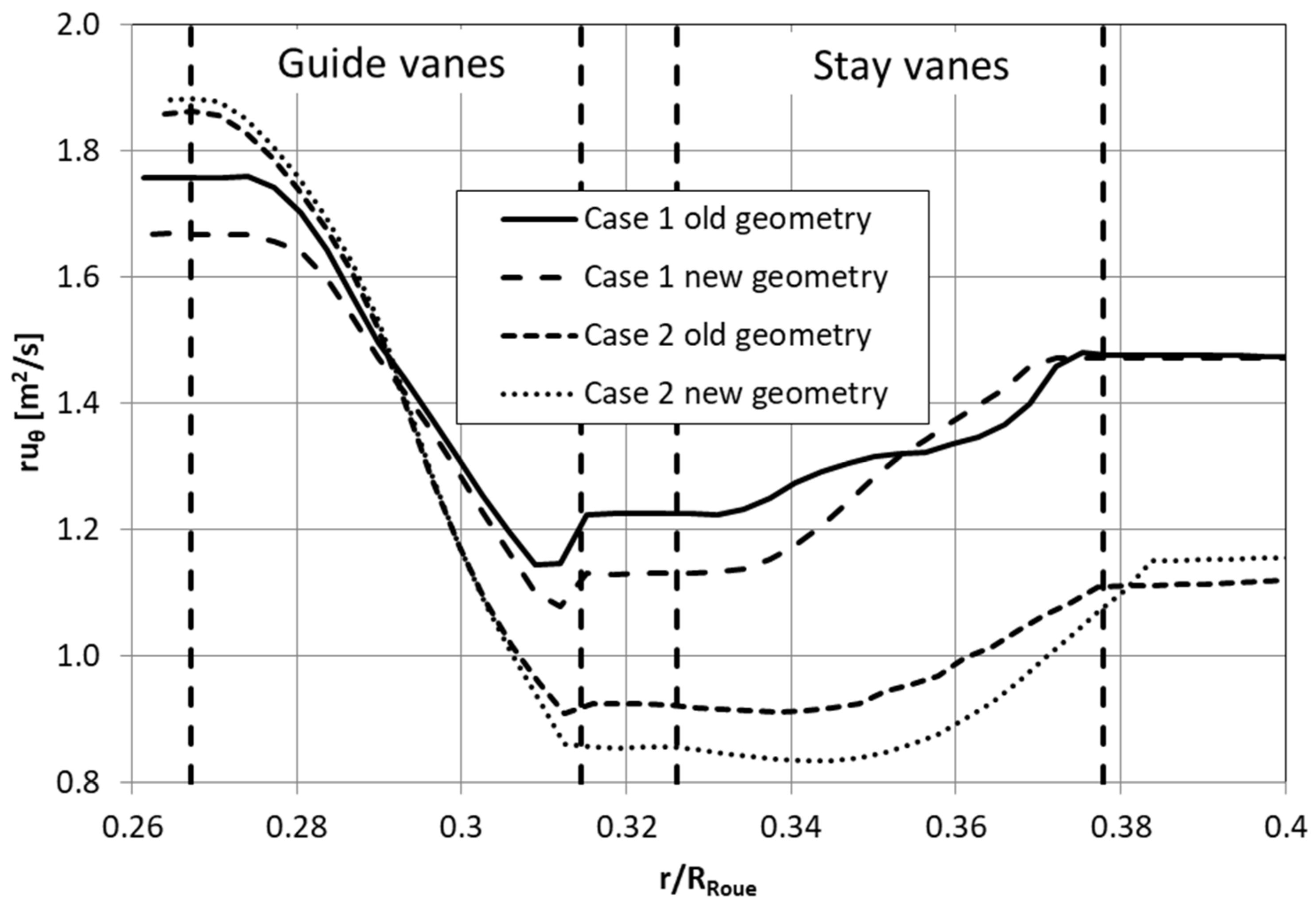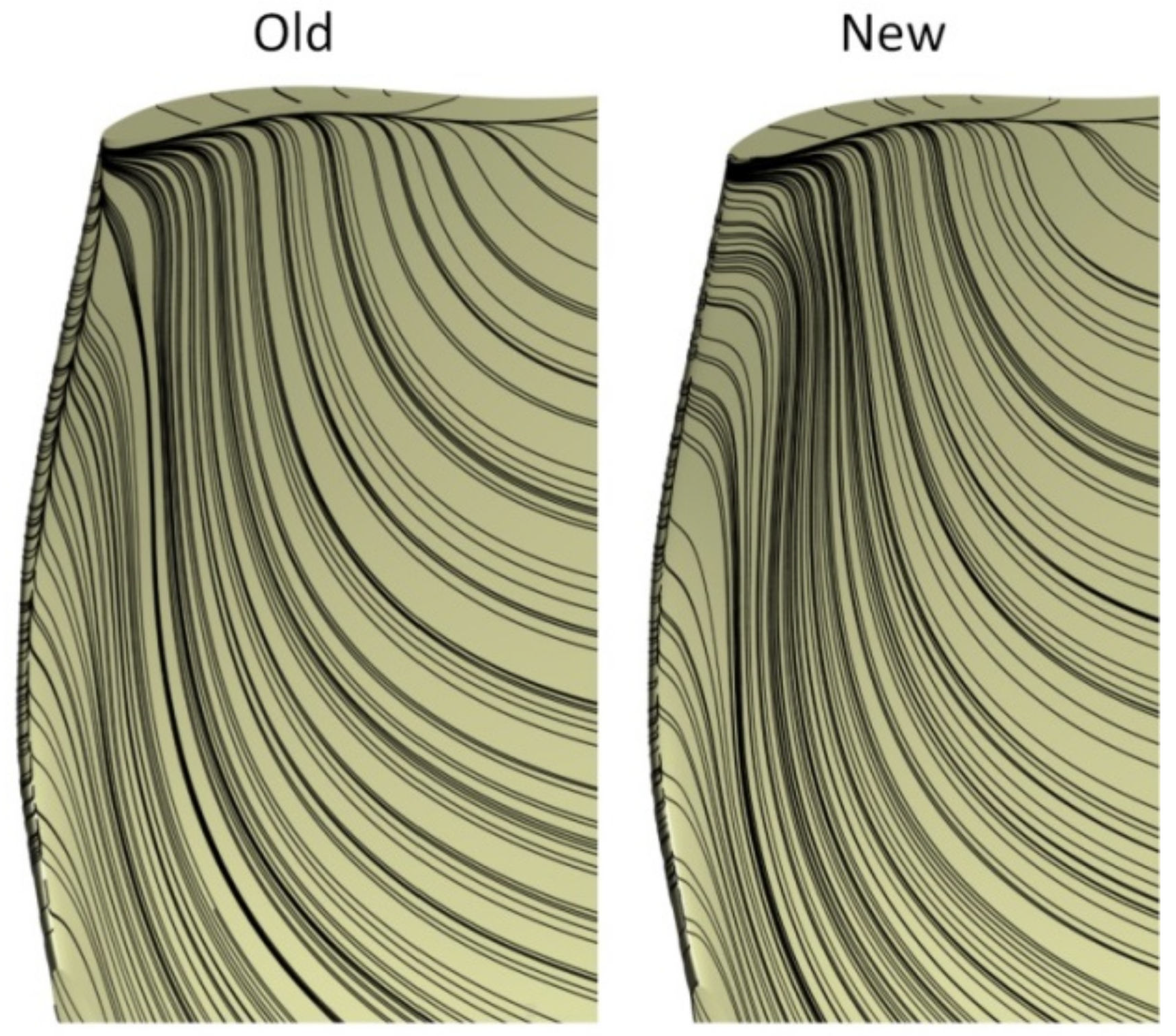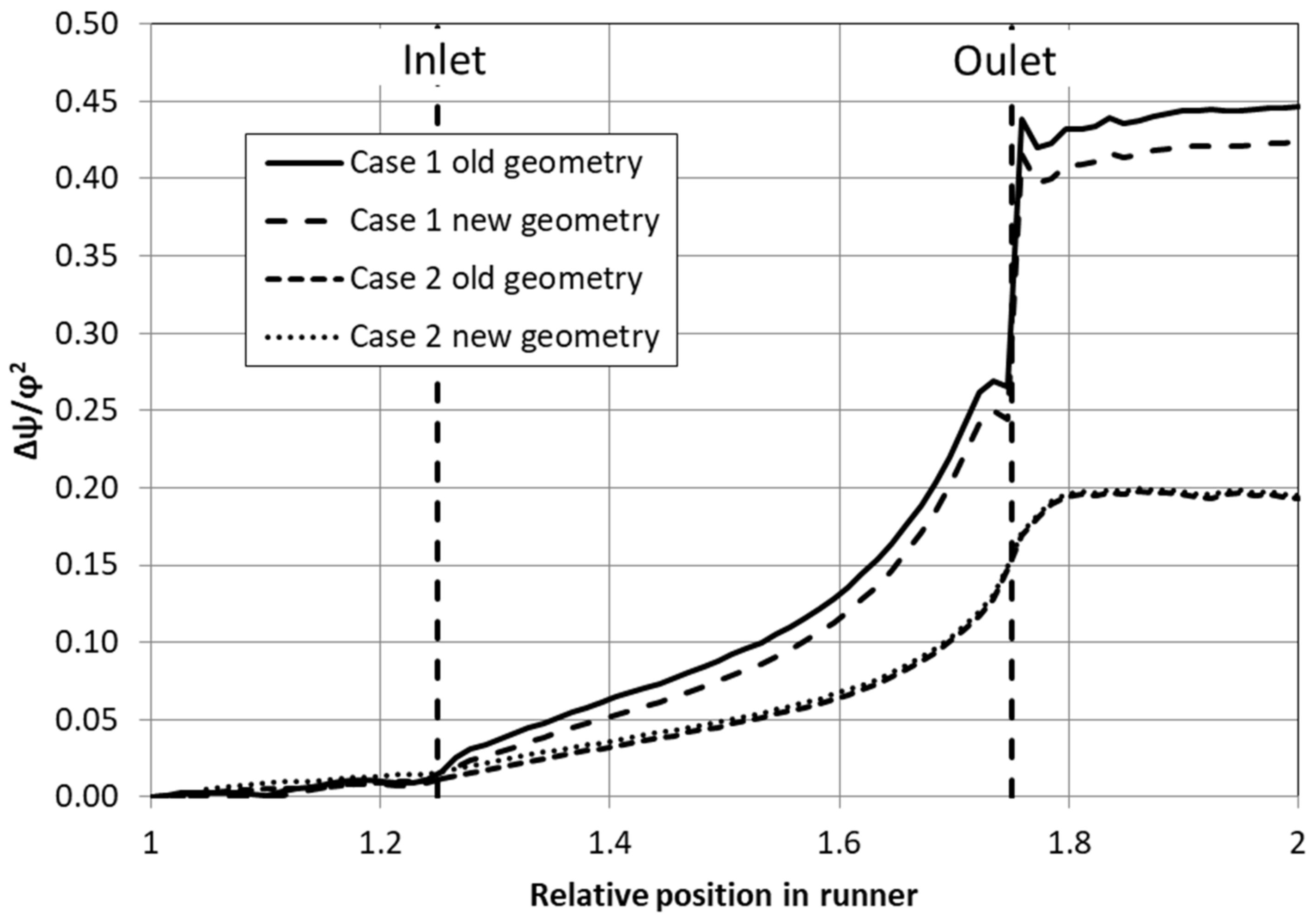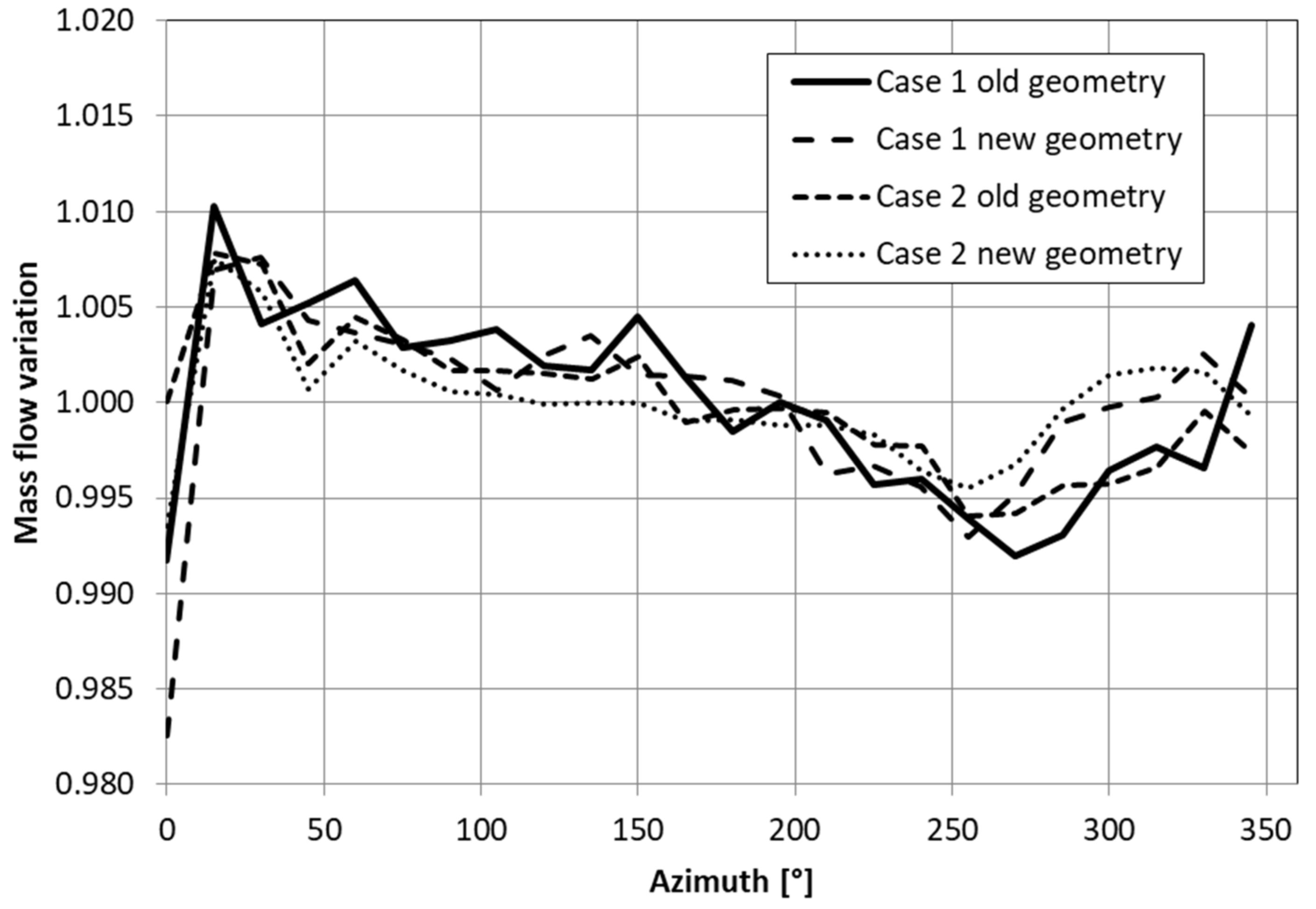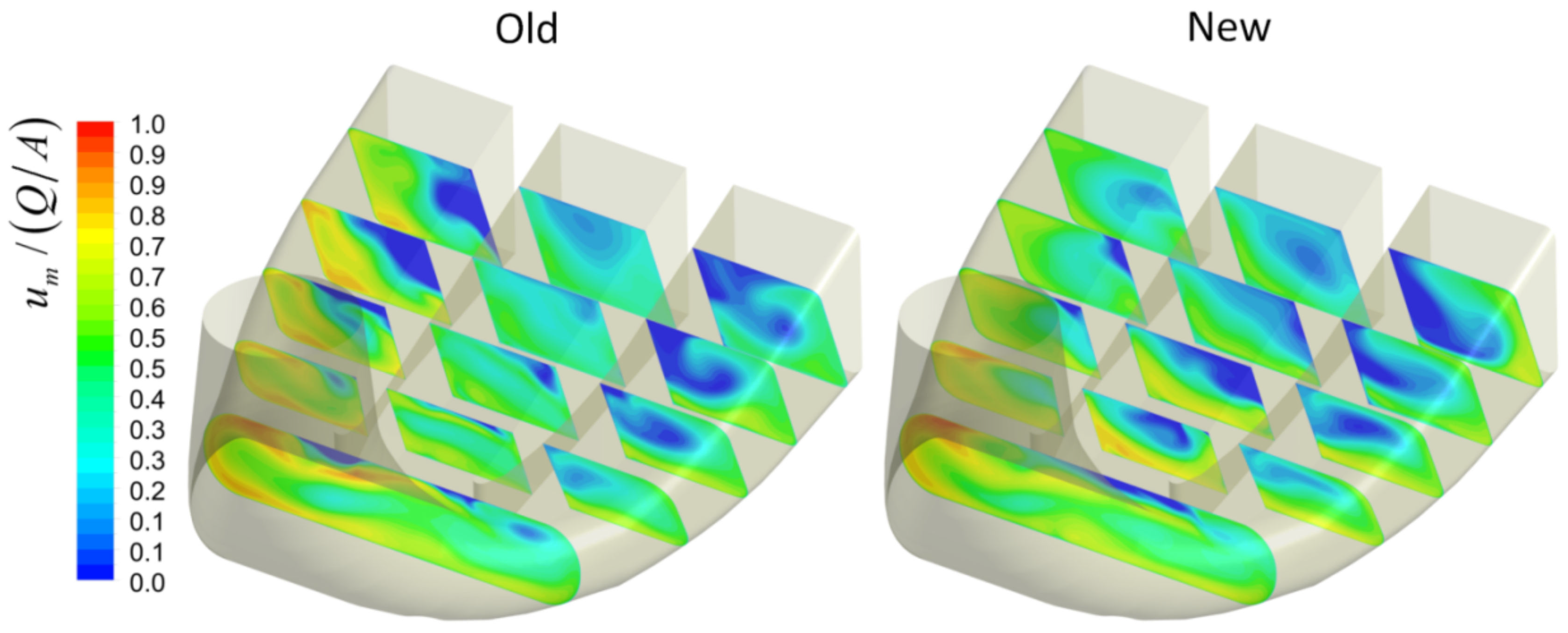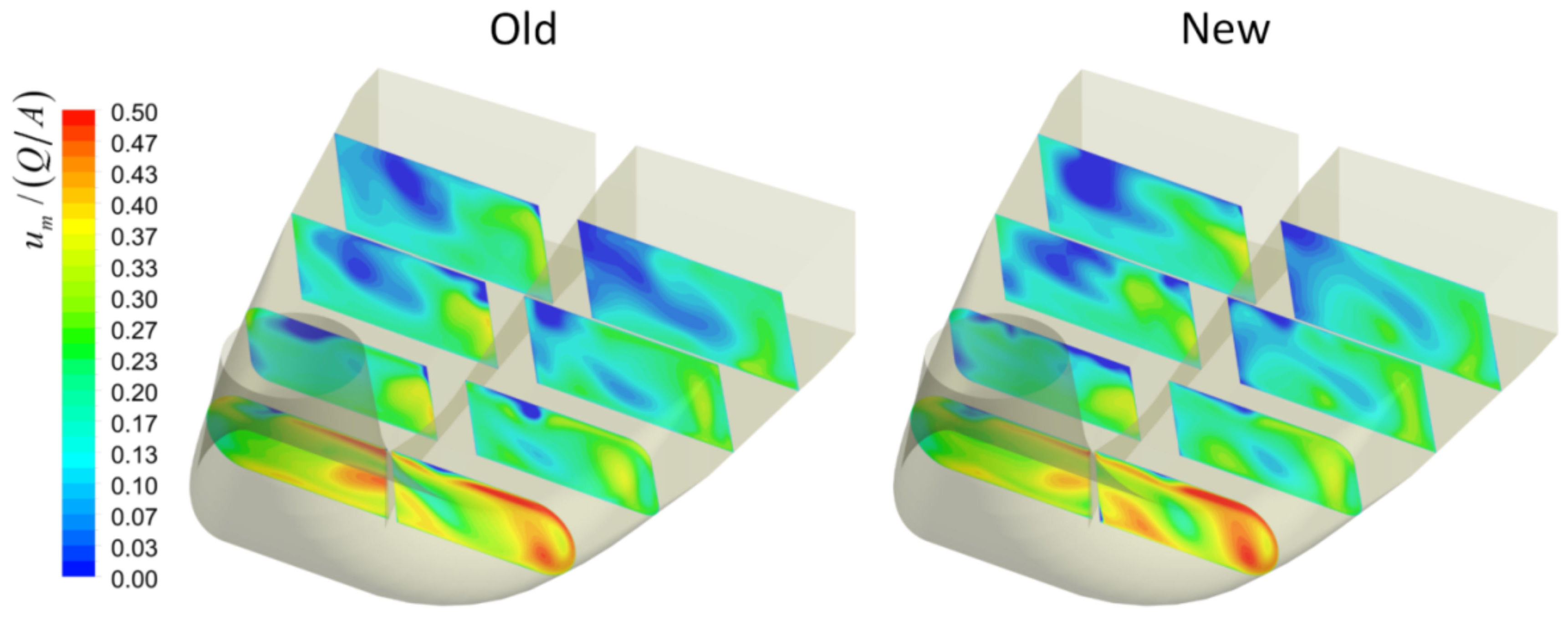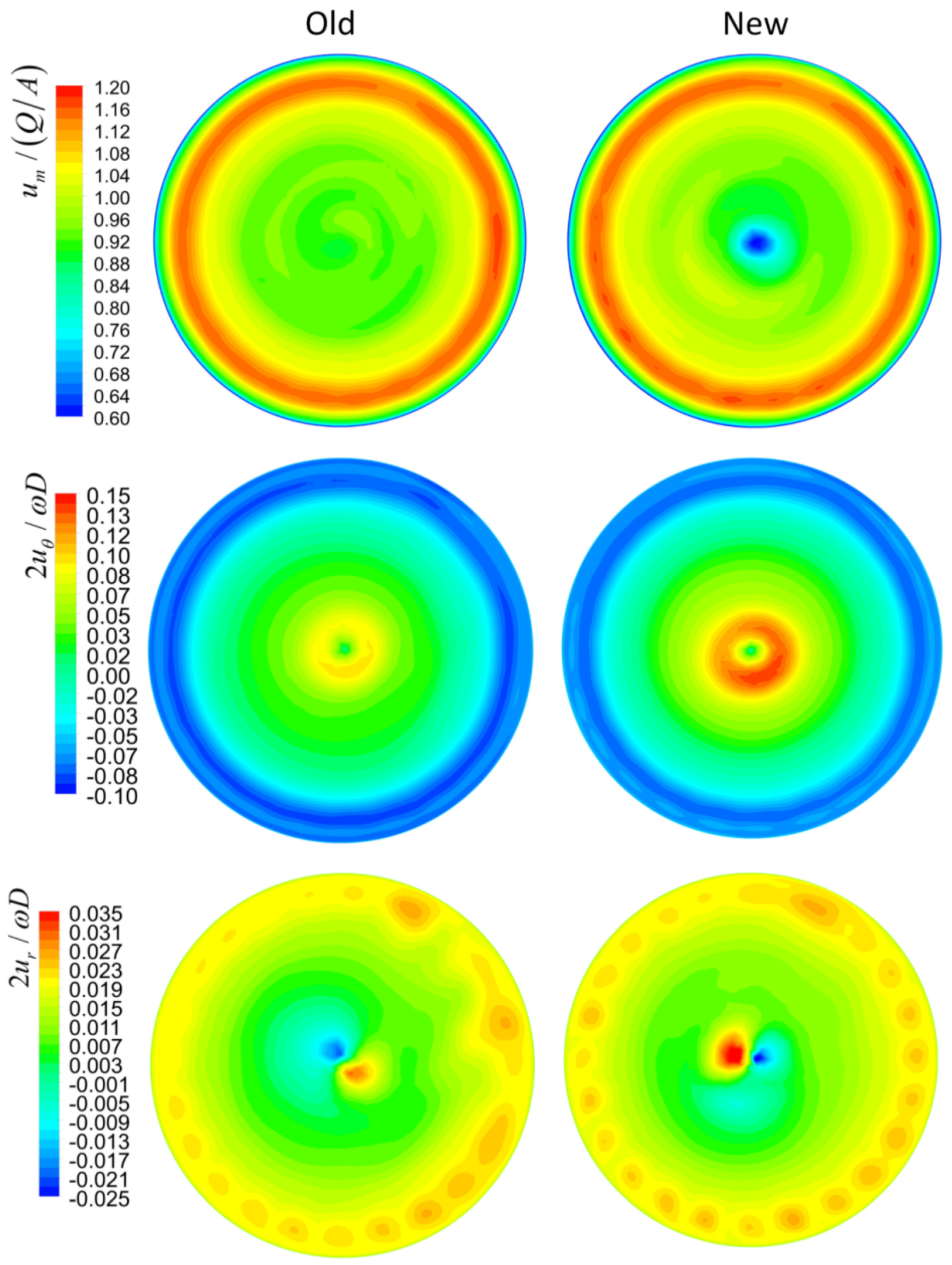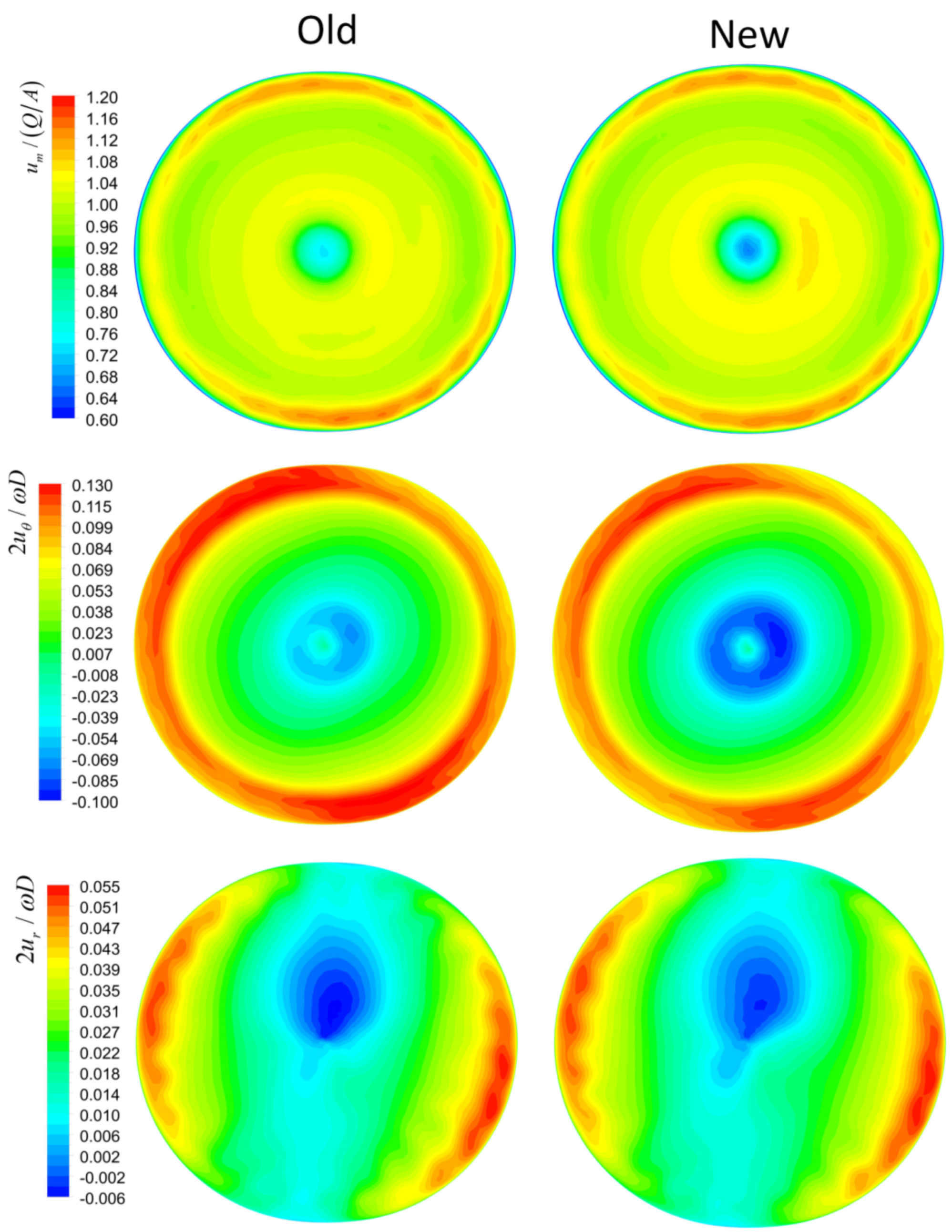The numerical results of full turbine simulations are used to assess efficiency increase, in each component, due to SV modification compared to that measured in model tests in both cases studied.
3.2. Tandem Cascade
Figure 9 shows the efficiency loss coefficient as a function of the tandem cascade radius for the two cases studied. The comparison of the slope of the efficiency loss coefficient between the old and new geometries shows that in case 1, the main source of efficiency loss is located at the leading edge of the SVs. The other major efficiency losses are located at the exit of the old SVs in case 1. In the absence of new efficiency losses in the GVs, the slope is very similar between the two geometries for both cases.
In case 2, the difference in the slope of the efficiency loss coefficient between the two geometries is reduced relative to that of case 1. The slopes of the efficiency losses at the SVs of the old geometry are generally constant. They are only somewhat greater than those of the new SVs, and almost identical in the GVs. Similar to case 1, the increase is mostly generated in the SVs for both geometries.
According to the observation of the efficiency loss coefficient in the tandem cascade, the significant reduction of efficiency losses is due to the elimination of the boundary layer separation at the SVs due to their modifications. The velocity at the SVs of the two geometries,
Figure 10 and
Figure 11, indicate the large boundary layer separation caused by the misalignment of their leading edges with the flow, as shown by the position of the stagnation point where the velocity is zero.
The flow misalignment is much more significant in the old geometry than in the new one, as the modification of the SVs significantly reduced the misalignment of their leading edges with the flow (see
Table 8). This is the main cause of the recirculation zones and of the large efficiency losses in the old geometries of the two cases studied.
Added to the misalignment of the SVs to the flow, the velocity contours highlight the difficulty of a chamfer leading edge to keep the flow attached to the wall, as in case 1. Indeed, the velocity at the leading edge of the SVs reveals that the flow detaches from the wall on sharp chamfer angles due to the strong adverse pressure gradient created there. This is the boundary layer separation point and the beginning of the recirculation zone at the SVs. A boundary layer separation is also observed very locally on the SVs’ intrados. This separation shows the main weakness of chamfer geometry, as it creates efficiency losses even if the flow is properly oriented with the hydraulic profile. The modification to the SV’s geometry with a rounded leading edge attenuates this problem and reduces the incidence of flow misalignment, as evidenced by the velocity contour.
In case 2’s old geometry, the leading edges are appropriate to limit the boundary layer separation; however, the velocity contour shows the important misalignment of approximately 24° of the flow with the SVs. The increase in the adverse pressure gradient is due to the rapid change in direction of the SV’s leading edges. Indeed, this is the point of the boundary layer separation. By reducing the misalignment with the flow, the extension added to the new geometry attenuates the rapid change in direction of the SVs and therefore the magnitude of the adverse pressure gradient. However, the effect of a long application of adverse pressure gradient is observed on the upper surface of the SVs in the form of the flow slowing in the boundary layer. This slowing reveals the work of the SVs done on the flow to obtain an adequate orientation with the GVs.
Flow observations at the tandem cascade show that the modification of the SVs eliminates all the recirculation zones (flow velocity almost zero) in the tandem cascade in both cases studied, as indicated in
Figure 12 and
Figure 13. In case 1, modification of the trailing edge of the SV also reduces its prominent wake. At the SVs located at the end of the spiral case with the small recirculation zone, a much larger wake is observed in the original geometry compared to the wake in the modified one. In both cases, the recirculation zones are closed in the GVs due to the flow restriction caused by the significant reduction of the flow section. This effect on the flow is visible through the zones of higher flow velocity at the entrance of the GVs.
Figure 14 and
Figure 15 show the large boundary layer separation in the old geometry with the recirculation zone highlighted by an isosurface of zero flow velocity (u
m = 0) and a contour of the flow velocity on the tandem cascade horizontal plane. Boundary layer separation is accentuated at the tandem cascade horizontal plane from the higher radial component of the flow at this location caused by the secondary flows in the spiral case. These figures show that the modification eliminates the boundary layer separation over the entire height of the SVs in the original geometry. However, the thinner trailing edge of the SV in case 1 adds a small recirculation zone near the flange, starting from the exit of the flange and the SV’s curve that lead to a local adverse pressure gradient increase.
The azimuthal variation of the recirculation zones shows the variation of the flow direction at the leading edge of the SV. The spiral case imposes a more radial flow at its beginning and end while imposing a tangential direction to the flow in the middle, as shown in
Figure 16. In both cases, the evolution of the azimuthal flow in the spiral case indicates this is a deceleration flow type; a result of the configuration of the spiral case [
37]. This figure also shows, by its comparison between the old and new geometries, the absence of any influence of the recirculation zones on the flow direction at the SV’s leading edges.
Recirculation zones in the tandem cascade affect the components of the mean flow at the exit of the GVs in the old geometry of case 1, as shown in
Figure 17, with the angular momentum as a function of the radius. They have no effect on the angular momentum in the old geometry in case 2. Indeed, the recirculation zones in the original geometry increase the angular momentum provided to the GV’s outlet.
The effect of the recirculation zone can be noted at the boundary layer separation point on the leading edge of the SVs by a fast decrease in the angular momentum. The flow area reduction by the flow recirculation zones then increases the tangential component of the flow in the SVs. This result of a tangential flow at the exit of the SVs is significantly higher in the original geometry of case 1. For the old geometry, a similar effect is found in case 2 as the flow gains in angular momentum at the SV’s exit. In this case, it also appears that the recirculation zone partially blocks the radial component of the flow, thereby increasing the tangential flow. The comparison of the angular momentum at the exit of the GVs between the two geometries of case 2 shows that they restored the flow. However, in case 1, the old geometry maintains a higher angular momentum than the new one. This difference between the two geometries is due to the position of the SVs relative to the position of the guide vanes. The alignment of the GVs with the SVs in case 2 closes the recirculation zones and promotes the restoration of flow through the strong attenuation of the wake. On the contrary, in case 1, the position of the SVs between two GVs leads to the large wake of the recirculation zones at the exit of the GVs. This large wake creates a deficit of radial velocity with the effect of increasing the tangential flow, as at the exit of the SVs.
3.3. Runner
The efficiency loss variation between the old and new geometries in the case 1 runner is affected by the variation of the average flow component at the GV’s outlet. It is observed that the modification of the flow’s angular momentum by the recirculation zone in the old geometry implies a greater flow misalignment on the blade’s leading edge, as shown in
Figure 18. In case 2, the absence of efficiency loss variation is the consequence of the very similar average flow component between the two geometries at the GV’s outlet.
Using the average velocity components, the hydraulic angle difference at a blade leading edge between the two geometries is about 0.35°. In contrast, the variation of the angle between the partial and the high load operation points is about 3°. If the flow misalignment is greater than that of the old geometry, it remains attached to the wall of the blade as shown by the streamline, with an increase of the energy runner head and efficiency losses.
The observation of the efficiency loss coefficient as a function of the relative position in the runner,
Figure 19, confirms the greater efficiency losses at the runner inlet in the old geometry of case 1. In comparison, case 2 shows no variation in runner efficiency losses between the two geometries.
As a comparison of the mass of flow distribution at the GV outlet,
Figure 20, shows the absence of differences due to recirculation zones between the old and new geometries. According to this figure, the mass flow distribution is very similar for the two geometries in each case study. The mass flow distribution at the GV outlet is rather a function of the spiral case geometry than of the SV. Thus, since the mass flow distribution is similar in both geometries of the two cases, it does not influence the efficiency losses in the runner. The runner energy head is considered as the main head loss source in the hydraulic turbine and as a factor that has a major effect on the flow uniformity and distribution at the GV outlet.
3.4. Draft Tube
Figure 21 and
Figure 22 show the velocity flow obtained with the full turbine simulations at different planes in a draft tube. Some differences are observed between the old and new geometries of the two cases, such as the recirculation zones, characterized by zero flow velocity at the outlet of the draft tube. It is observed that the flow at the beginning of the sluice is quite similar in both geometries, and then small differences appear in the development of recirculation zones. However, the overall topology of the flow is very similar for the draft tube of both the old and new geometries. Indeed, the total area blocked by the recirculation zones at the exit of the draft tube appears to be substantially the same in both geometries, which is why the low-efficiency loss coefficient reduction is evaluated in the new geometry according to the IEC method.
Comparison of the flow at the runner outlet between the old and new geometries of case 1 gives some clues about the slight difference observed in the flow in the draft tube, as exposed in
Figure 23, with circumferential, radial, and axial velocities. There are larger differences between the two geometries in the axial and circumferential velocities, due to the mass flow variation imposed at the turbine inlet. In fact, the simulation uses the operating point determined in a test model for each geometry. This implies that there is more circumferential velocity at the runner output in the new geometry, made visible by a larger recirculation zone at the center of the draft tube.
Figure 24 shows that SV modifications bring no significant changes in the velocity fields at the case 2 runner outlet. Note that the significant imbalance of the radial velocity, and to a lesser extent, the axial velocity, is the consequence of the oblong shape of the draft tube cone. In fact, the radial velocity at the wall is mainly led by the divergence angle of the draft tube cone [
23]. Due to its particular shape, the divergence angle varies along the perimeter of the tube cone and increases the radial velocity at each side of the oblong. The effect on the axial velocity is similar; where the divergence angle is larger, the more it decelerates the flow.
In both cases, the full turbine simulations do not capture the effect of eliminating the recirculation zones in the tandem cascade at the runner outlet. The change of the mean flow comes from the flow rate imposed at the turbine inlet, as measured in the model tests for the same GVs’ opening. The mean flow at the runner outlet is mainly a function of the flow rate, the runner blade shape, and the rotational speed, according to the velocity triangle [
38]. As expected, the numerical simulation shows lower circumferential velocity for the new geometry’s runner outlet, as the flow rate is higher.

